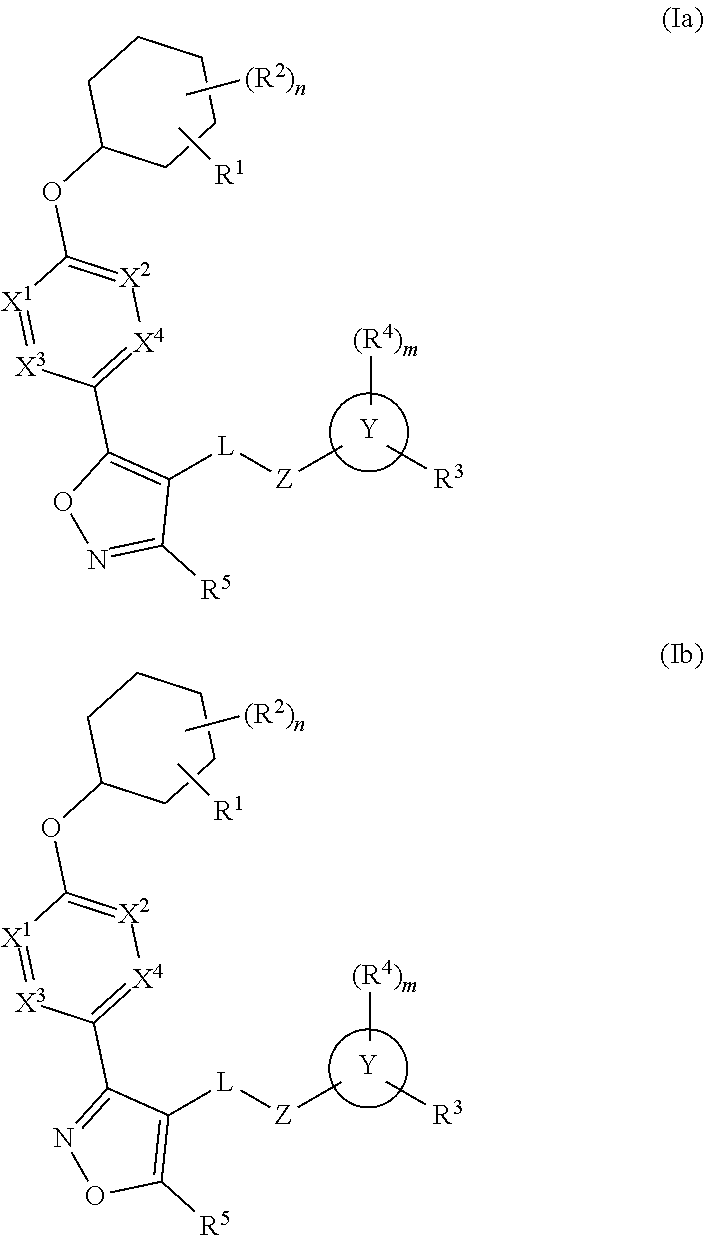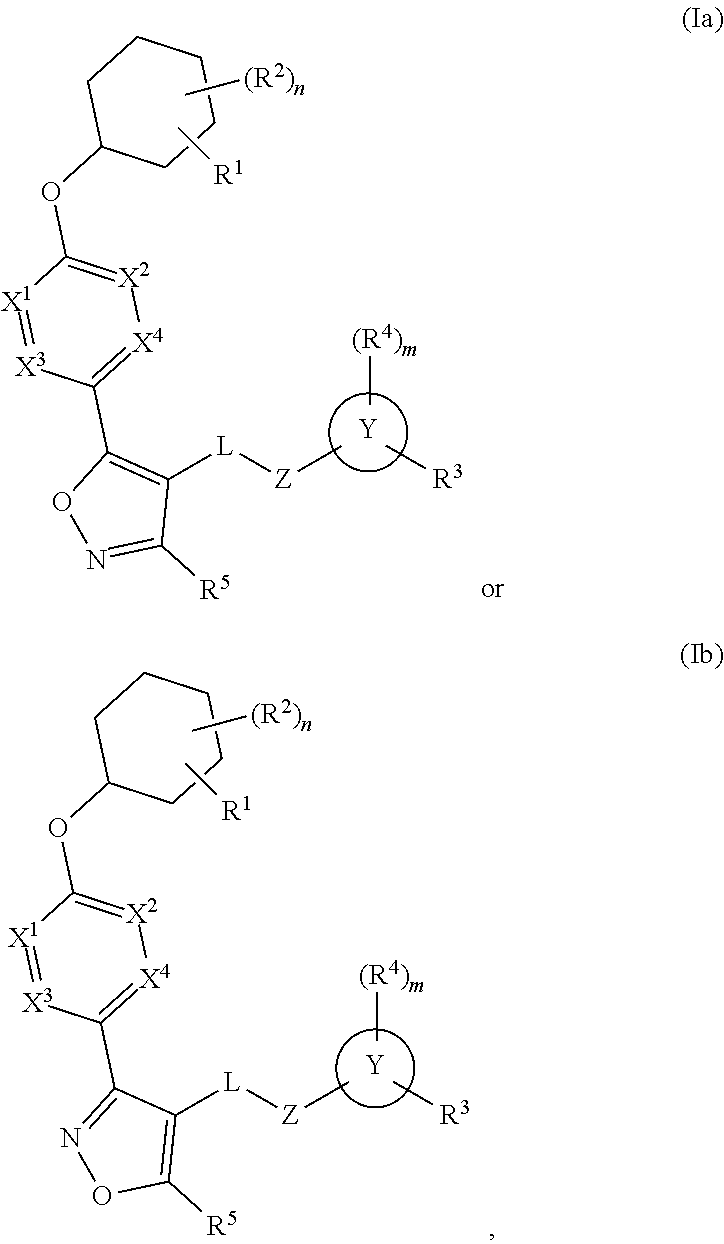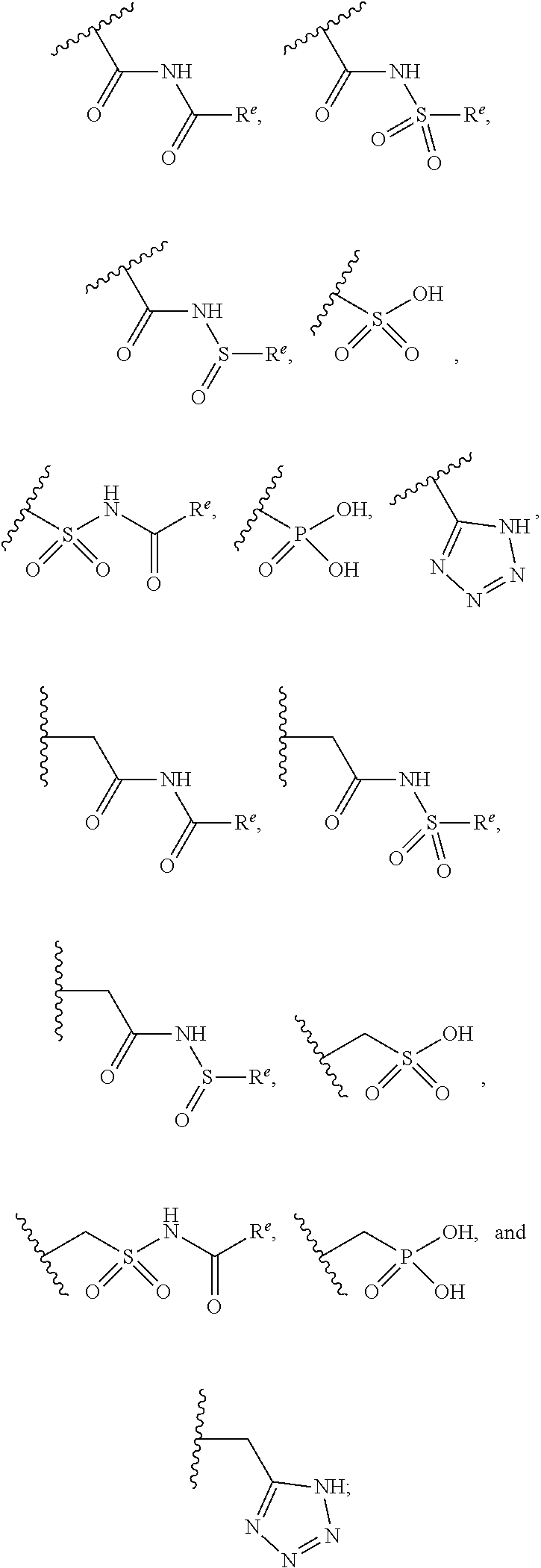Cyclohexyl acid isoxazole azines as lpa antagonists
a technology of isoxazole azines and cyclohexyl acid, which is applied in the field of new substituted isoxazole compounds, can solve problems such as end-organ failur
- Summary
- Abstract
- Description
- Claims
- Application Information
AI Technical Summary
Benefits of technology
Problems solved by technology
Method used
Image
Examples
example 1
[0556]A mixture of 1D (250 mg, 0.474 mmol) and LiOH.H2O (398 mg, 9.48 mmol) in MeOH (2 mL), THF (5 mL) and H2O (5 mL) was stirred at RT for 6 h, then was concentrated in vacuo. The residue was acidified with 1N aq. HCl to pH=−3-4, then was extracted with EtOAc (5×5 mL). The combined organic extracts were dried (MgSO4) and concentrated in vacuo. The crude product was purified by preparative HPLC (YMC reverse phase ODS-A-5u 30×100 mm column; flow rate=40 mL / min, 20 to 100% solvent B over 30 min, hold to 40 min, where solvent A=90:10:0.1 H2O:CH3CN:TFA and solvent B=90:10:0.1 CH3CN:H2O:TFA) to afford the title compound (135 mg, 0.272 mmol, 57.5% yield) as a white solid. LCMS [M+H]+=486.2. 1H NMR (500 MHz, CDCl3) δ 8.62 (d, J=3.0 Hz, 1H), 8.21 (s, 1H), 8.04 (d, J=7.8 Hz, 2H), 7.89 (d, J=8.7 Hz, 1H), 7.69-7.62 (m, 1H), 7.56 (t, J=7.8 Hz, 2H), 7.38 (dd, J=8.7, 2.8 Hz, 1H), 7.18 (d, J=6.4 Hz, 1H), 5.08-4.93 (m, 2H), 4.81 (s, 1H), 2.46 (s, 3H), 2.16-1.65 (m, 8H). hLPA1 IC50=14 nM.
Example 2. ...
example 2
[0562]To a solution of 2B (13 mg, 0.026 mmol) in THF (0.8 mL) / MeOH (0.4 mL) / H2O (0.4 mL) was added LiOH.H2O (6 mg, 0.13 mmol). The mixture was stirred at RT overnight, then was concentrated in vacuo. The residue was taken up in EtOAc (2 mL) / H2O (1 mL), and the solution was adjusted to pH˜5 with 1N aq. HCl. The mixture was extracted with EtOAc (3×2 mL); the combined organic extracts were dried (MgSO4) and concentrated in vacuo. The residue was dissolved in DMF and purified via preparative LC / MS: Column: XBridge C18, 19×200 mm, 5-μm particles; Mobile Phase A: 5:95 MeCN:H2O with 0.1% TFA; Mobile Phase B: 95:5 MeCN:H2O with 0.1% TFA; Gradient: 16-56% B over 20 min, then a 4-min hold at 100% B; Flow: 20 mL / min Fractions containing the desired product were combined and dried via centrifugal evaporation to afford the title compound (bis TFA salt; 5.2 mg, 7.2 μmol, 28% yield; 96% purity by LCMS). LCMS [M+H]+=467.2. 1H NMR (500 MHz, DMSO-d6) δ 8.61-8.41 (m, 1H), 8.35 (br s, 1H), 7.78-7.70 (m...
example 16
-((6-(3-Methyl-4-(((4-phenylpyrimidin-2-amino)methyl)isoxazol-5-yl)pyridin-3-yl)oxy)cyclohexanecarboxylic Acid
[0563]
[0564]To a 0° C. mixture of 4-phenylpyrimidin-2-amine (59 mg, 0.34 mmol) in DMF (1.5 mL) under N2 was added NaH (14 mg of a 60% dispersion in oil, 0.35 mmol). The reaction was stirred for 30 min at 0° C., after which intermediate 1 (50 mg, 0.11 mmol) was added. The reaction was allowed to warm to RT and stirred at RT for 1 h. LCMS showed that the starting material was completely consumed. The mixture was concentrated in acuo and the residue was purified by preparative LC / MS using the following conditions: Column: XBridge C18, 19×200 mm, 5-μm particles; Mobile Phase A: 5:95 MeCN:H2O with 10-mM aq. NH4OAc; Mobile Phase B: 95:5 MeCN:H2O with 10-mM aq. NH4OAc; Gradient: 20-65% B over 30 min, then a 5-min hold at 100% B; Flow: 20 mL / min. Fractions containing the desired product were combined and dried via centrifugal evaporation. The title compound (7.8 mg, 13% yield) was o...
PUM
| Property | Measurement | Unit |
|---|---|---|
| Molar density | aaaaa | aaaaa |
| Molar density | aaaaa | aaaaa |
| Fraction | aaaaa | aaaaa |
Abstract
Description
Claims
Application Information
 Login to View More
Login to View More - R&D
- Intellectual Property
- Life Sciences
- Materials
- Tech Scout
- Unparalleled Data Quality
- Higher Quality Content
- 60% Fewer Hallucinations
Browse by: Latest US Patents, China's latest patents, Technical Efficacy Thesaurus, Application Domain, Technology Topic, Popular Technical Reports.
© 2025 PatSnap. All rights reserved.Legal|Privacy policy|Modern Slavery Act Transparency Statement|Sitemap|About US| Contact US: help@patsnap.com



